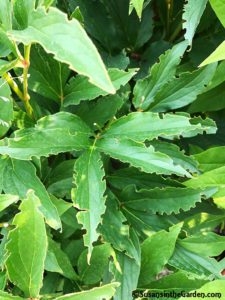Root Weevils
Family name: Curculionoidea
Size: Varies, 1/4″ and up
Color: Black or brown, beetles have a snout
Introduction: Root weevils are a large group of snout-nosed insects that are exceedingly frustrating and elusive in the garden. They are typically active at night and hide in the soil or beneath plants during the day. That certainly makes them tricky to spot. But their damage is often easy to spot, as you can see by the photo to the right. There are three weevils and we commonly we see in the Inland Northwest. They are the black vine weevil, strawberry root weevil and obscure root weevil, and the lilac or privet weevil.
Life cycle: Larvae overwinter in the soil near plant roots (so they can feed on them). They pupate in the soil and emerge as adult beetles in early summer. The beetles feed on the edges of leaves. After a couple of weeks, the females mate and lay eggs at the base of plants. That begins the cycle once again. They have one generation in a year.
Signs of their activity: Notched edges of leaves.
Typically seen on: Peonies, strawberries, rhododendron, yew.
Controls: For the most part, the damage caused by weevils is more aesthetic. However, if there is a huge population of weevils, they can cause more significant damage. The safest control involves placing sheets or plastic beneath the plants, shaking the weevils off the plants at night, and disposing of them. There is also information that Spinosad is effective on them but care must be taken to avoid spraying any flowering plants with it since it will kill bees. There are some other types of bio-insecticides but careful review of the labels is a must.
Natural predators: Parasitic nematodes.
Additional information: Root Weevils – Washington State University Garden Tips, Root Weevils – Colorado State University, and Landscape Pests: Root Weevil (Pacific NW Pest Management Handbook).
Back to Organic Pest Control

